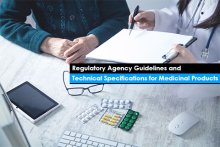Back in 2012 an ordinance was passed under which all the drug applications to the Saudi Food and Drug Administration (SFDA) were required to be processed through the electronic common technical document (eCTD). It was only till Jan. 3, 2015 that the non-eCTD electronic submission including NeeS format were allowed, and thereafter it was mandatory for SFDA to accept electronic CTDs. Hence, eCTD implementation by SFDA was effective only from this year.
Here were some further actions undertaken w.r.t their road map towards eCTD implementation
- NeeS submissions for human medicinal product dossiers were only accepted from December 20, 2011 onwards by the SFDA as per the “Guidance for Submission”
- The NeeS format became mandatory submission format for the SFDA from September 01, 2012 onwards
- No other formats except for electronic CTD were accepted
- eCTD became fully functional on January 05, 2013 that was preferred as submission format one year later in 2014
- Since January 03 2015 only eCTD is being accepted
Synthesizing regulatory policies worldwide
The pharmaceutical industry is tantamount to being one of the most regulated industries in protection of health and well-being of the general public. The regulatory policies of EU and US-FDA are deemed to be standard for the regulatory agencies worldwide. ICH brought regulatory authorities and pharmaceutical industries of Europe, Japan and US together for various aspects of drug registration.
Similarly, countries from Asia Pacific and Gulf are in process of harmonization with mutual concern as The Association of Southeast Asian Nations (ASEAN) and Gulf Co-operation Council (GCC).
The GCC region is considered as the “Emerging Market” for pharmaceutical export and bilateral trade. The Ministry of Health of GCC States (which include Bahrain, Kuwait, Oman, Qatar, Saudi Arabia and UAE) are the regulatory authorities for the regional Pharma sector. They also regulate prices of pharmaceutical products and bring about harmonization of varying prices and the regulatory process, the GCC implemented a centralized system, Gulf Central Committee for Drug Registration (GCC-DR) in May 1999, which currently runs parallel to the regulatory regimes in the region.
The Saudi Food and Drug Authority
SFDA is the main drug regulatory body of the Kingdom of Saudi Arabia (KSA). It is considered to be the most stringent and advanced body among GCC cooperation.
To cope up with the ever changing regulation across the globe, the SFDA has taken an initiative of adopting the efficient EMA directives and regulations. As a part of this initiative, it has started accepting submissions in the form of eCTD from Jan 2013. Now that the guidelines has been efficiently drafted and success of the eCTD submissions till date, the SFDA has brought in new regulations stating that from Jan 2015 eCTD format is mandatory for filling any applications to SFDA.
The SFDA eCTD Module1 is slightly different from EU Module1 that it contains additional information requesting the MAH to make declarations as listed below.
1.7.5. ALCOHOL-CONTENT DECLARATION
• This section should contain a declaration letter in an official company letterhead stating that the product is free from alcohol
1.7.6. PORK-CONTENT DECLARATION
• This section should contain a declaration letter in an official company letterhead stating that the product is free from any materials of pork/porcine source
1.8. PRICING
• The applicant shall include the price of the product in countries listed in the SFDA Guidance for submission
Technical Baseline Applications
A baseline submission is nothing but an organized set of submissions featuring the present rating of the report i.e. resubmission of the valid documents in appropriate format that have already been handed over to the SFDA.
When an eCTD application is used for the first time especially for the renewal process, the applicant is required to submit a technical baseline for the product. This method further facilitate the review process at ease.
The cover letter of the “baseline eCTD sequence” should clearly indicate that the content of the submitted dossier has not been changed and it’s only the format that is modified. While hyperlinks between the documents are not necessary, the ‘reformat’ submission type should be used in the envelope for the baseline sequence.
eCTD implementation by SFDA
One of the fundamentals of eCTD is that the lifecycle of a product can be managed with the use of the operation attributes, whilst conceiving a bird’s eye view of the ‘current report’.
In order to convert a NeeS format to eCTD, baseline submission is essential.
What is baseline submission?
A baseline submission is the resubmission of any valid document so as to initiate the eCTD format and is submitted as a 0000 sequence.
The 0000 sequence baseline submission
The baseline should always be submitted individually without adding new applications. And the next variation in eCTD format should only be submitted as sequence 0001 and the additional data, the sequence number goes as 0002, 0003 and so on.
| Sequence Number | Submission Description | Submission Type | Related Sequence |
| 0000 | Baseline of Module 1 + Module 3 | Reformat | None |
| 0001 | Variation for new indication | Var-type 2 | None |
| 0002 | Response to questions | Supplemental-info | 0001 |
How to apply for a baseline eCTD submission?
Responses to Questions – It will follow the original submission1
Variations and Renewal – It will follow the original submission until the 17th of July 2016.
Factors regarding implementation of eCTD by SFDA
- SFDA urges applicants to move to full eCTD i.e. from m1 to m5
- The applicant has the right to upgrade to eCTD
- Baseline submission is required. However, once eCTD is submitted, changing to any other format cannot be accepted
- Submission of a baseline must be done at the end of a regulatory activity
So those were the following initiatives taken during the process of eCTD implementation by SFDA.





